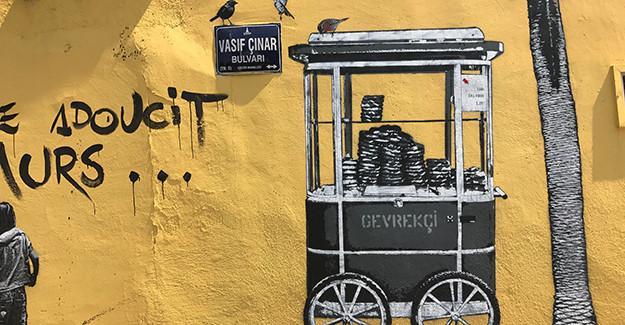Izmir’s (un)forgotten figures by French Bansky
Nazlan Ertan - nazlanertan@gmail.com
 It is around 30 degrees Celsius under the sun when an elderly figure, huffing and puffing, stands before a wall and points at the life-size figures painted on it. “What are you doing?” he asks, with the sense of entitlement of a true Izmirian, to the woman at a small work table. “Who are those people you are putting on our walls?”
It is around 30 degrees Celsius under the sun when an elderly figure, huffing and puffing, stands before a wall and points at the life-size figures painted on it. “What are you doing?” he asks, with the sense of entitlement of a true Izmirian, to the woman at a small work table. “Who are those people you are putting on our walls?”The French woman is Yveline Perroy, the wife of French mural artist known as Jeff Aerosol, who looks at the man with incomprehension. The artist himself, a tall figure in a red t-shirt and a Panama hat, starts moving away. It falls on me, a chance passer-by, to translate in halting French. She then simply points out one of the figures on the wall, that of Dario Moreno, the İzmir-born Turkish-Jewish polyglot singer and composer who attained fame and made a remarkable career in France.
Suddenly, almost as if in a movie, the self-righteous Turk and the French woman sweating under the sun start singing together: “Si tu vaaas a Rioooo” – arguably Moreno’s best known lyrics.
Jeff Aerosol’s life-size figures on the wall on one of İzmir’s main traffic axes, on Vasıf Çınar Street, is within the framework of a permanent exhibition on the wall of the French Cultural Center in Izmir. The title is “Shared Differences” –a wink of the eye to what Smyrna, the city of Greeks, Jews and Levantines, brought to the Ottoman Empire’s cultural richness; as well as the figures on the wall.

On this wall, a whirling dervish is side by side with a hip-hop dancer, and a man playing the Turkish instrument “saz” peacefully looks at you, with the figure of a clarinet-player on his side. Henry Langlois, the İzmir-born titan of the French cinema and the founder of the French Cinémathèque, a body established in the 1930s to screen, preserve and archive films.
Jeff Aerosol, born Jean-François Perroy in 1957 in Nantes, describes himself as “an urban stencil artist” who belongs to the first generation of street artists who started working on the streets in the early 1980s.
Sometimes called the “French Banksy,” his work can be found in many cities around the world: Paris, London, Athens, Venice, Rome, Amsterdam, Chicago, New-York, Los Angeles, San Francisco, Brussels, Zurich, Beijing, Tokyo, Palermo, Dublin, Belfast, Ljubljana... He even pasted-up his famous “Sittin’Kid” stencil on the Great Wall of China.
He spent four days in Turkey to paint this wall but spent a much longer time choosing the figures who would go there. “I do not want to put just any figure. They have to be the right people, people who mean something to the city and the people who live there,” he said. “The wall has to connect and interact with the city, with the people who go in front of it every day.”
He and Caroline David, the director of French Cultural Institute of İzmir and the curator for this activity, worked together to choose what would go on the wall – including a street-vendors cart that sells “gevrek” – the İzmirian word for “simit.”
But the wall’s artistic life will not stop after the official opening on June 1. Ayşegül Kurtel, Director of K2 Contemporary Art Center, will make a documentary on how the wall changes and intervenes with the people.
“The wall will change with time,” said Aerosol. “In the past, people wrote comments or other artists have added other figures. I find this positive.”
It remains to be seen what İzmir’s creative street artists will do to the wall. But knowing İzmir, painting a rakı table filled with fresh mezzes would not be unthinkable.
















